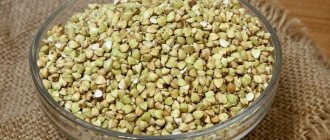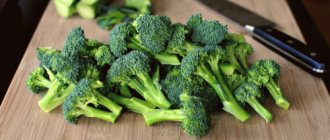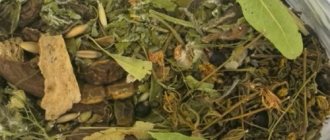Proper treatment of pancreatitis with parsley can speed up the patient’s recovery. According to folk healers and official medicine, this spice has a beneficial effect on the diseased gland, nourishes the weakened body with vitamin substances, but during an exacerbation of pancreatic disease it should not be used.
What medicinal recipes exist based on it, how to properly add it to dishes, whether it has side effects, as well as its healing effect on the pancreas will be discussed in this article.
Phytotherapeutic properties of parsley and its composition
Today, parsley has firmly entered our lives, its fresh emerald leaves are present in recipes for many dishes, but few people know that in addition to its vitamin composition, it was used as a cure for many serious diseases. Its phytotherapeutic properties have not been forgotten in our time; the plant is successfully used for many diseases, including pancreatitis.
The composition of parsley is distinguished by a wide variety of components beneficial to the body:
- Squirrels.
- Fats.
- Carbohydrates.
Among the vitamins and mineral elements it should be noted:
| Vitamins | Microelements |
| Beta-carotene (same as in carrots) Vitamin K Retinol (A) Thiamine chloride (B1) Folic acid (B9) Vitamin B6 Riboflavin (B2) Nicotinic acid (PP) Biotin (H) Tocopherol (E) Ascorbic acid (vitamin C) | Copper Zinc Potassium Iron Selenium Magnesium Sodium Manganese Calcium Phosphorus |
A common garden plant for us has the following healing properties:
- Shows antioxidant effect.
- Regulates the menstrual cycle.
- Improves immunity.
- Stimulates the functioning of the adrenal glands.
- Promotes the production of breast milk.
- Strengthens vascular walls.
- Has an anti-inflammatory effect.
- Improves metabolic processes.
- Regulates blood glucose levels.
- Increases intestinal tone.
- Improves visual acuity.
- Normalizes high blood pressure.
- Supports the functioning of the thyroid gland.
The list of unique properties of parsley does not end there.
The healing effect of greens on the pancreas for pancreatitis
Many patients with pancreatic disease are interested in how exactly parsley affects the diseased organ? The therapeutic effect of the nutritious plant can be characterized as follows:
- Stimulates gastric secretion.
- Relieves tissue swelling.
- Accelerates the regeneration of damaged tissues.
- Increases the capabilities of the immune system.
- Relieves pain in the pancreas.
Due to its year-round availability and active phytotherapeutic properties, parsley is an indispensable natural medicine in the home medicine cabinet.
In acute manifestations of pancreatitis
Parsley is strictly contraindicated for the pancreas in cases of acute pancreatitis. Gastroenterologists explain the categorical ban on its use during an exacerbation of the disease by the presence in its composition:
- Essential oils. These substances can enhance the secretion of pancreatic substances, which aggravates inflammation of the mucous tissues.
- Ascorbic acid. In 100 gr. plants present 100 mg. of this component, which is 2 times more than the daily requirement of the human body for this substance.
- Coarse vegetable fiber. Causes activity of all organs of the gastrointestinal tract, including the pancreatic ducts. Increased peristalsis leads to severe painful discomfort, excessive gas formation, nausea, vomiting and diarrhea.
In case of acute manifestation of pancreatic disease, one should refrain from consuming nutritious greens until the painful symptoms are relieved and laboratory tests confirm a stable improvement in the patient’s well-being.
When doctors allow you to expand your diet, parsley leaves and roots can be used to prepare pureed soups and dietary vegetable casseroles.
In the presence of chronic pancreatitis
The use of parsley for chronic pancreatitis is allowed only after the clear signs of the inflammatory process have diminished. Garden spice is added to vegetable stews, soups, salads, and is also used with other vegetables in the preparation of decoctions, on the basis of which a variety of dietary sauces are prepared.
During long-term remission, greens can become a valuable ingredient in many medical nutrition dishes. In this case, it is better to use the soft parts of the greens, without rough stems.
Parsley and acute pancreatitis
However, the height of acute pancreatitis is an absolute and categorical contraindication to the use of this wonderful plant. Parsley contains:
- essential oils that stimulate gastric, and through it, pancreatic secretion (increased synthesis of pancreatic enzymes is fraught with further aggravation of destructive inflammation in the pancreas);
- ascorbic acid (100 g of parsley contains 150 mg of this substance, this amount is twice the daily requirement of a healthy human body).
Therefore, its roots and greens are allowed to be included in pureed vegetable casseroles and pureed vegetarian soups only during the rehabilitation phase (if clinical symptoms disappear and laboratory tests normalize). The quantity is selected individually, based on the patient’s tolerability of the product.
Safe dosage of parsley-based medicines
Any medicine, even of plant origin, will benefit the body only if used correctly. Garden parsley is no exception.
In the table below you can see how much it is allowed to consume for different conditions of pancreatitis.
| Disease phase | Daily norm |
| Exacerbation | 20-30 g (bunch) baked or boiled. |
| Stable remission | No more than 20-60 g in fresh, stewed and baked form (with correct tolerance and normal secretory function of the pancreas). |
| Acute | 20 g (only during the rehabilitation period, boiled or baked). |
For medicinal decoctions prepared from the plant, you should adhere to the dosage indicated in the recipe or consult your doctor.
The most dangerous types of greens for pancreatitis
- sorrel;
- spinach;
- salad;
- Chinese cabbage;
- green onions;
- mustard.
All of them contain large amounts of essential oils, organic acids and fiber, and their use is strictly prohibited even during the period of remission.
Less dangerous types of greens for pancreatitis
- cilantro (coriander);
- tarragon (tarragon);
- basil;
- other aromatic herbs (rosemary, lovage, marjoram, thyme, oregano, mint, lemon balm, etc.).
They contain few organic acids, but have a high content of essential oils, which give these herbs a characteristic aroma. Spicy greens are allowed during a period of stable remission, preferably with preliminary at least minimal heat treatment, within 1-2 tsp. chopped greens per day (depending on the type of grass and its tolerance to the patient).
- dill;
- parsley;
- celery;
- caraway;
- fennel;
- watercress.
When these herbs are used correctly, they can diversify the taste of dietary dishes and enrich the diet with valuable vitamins and minerals. During the period of remission, these types of greens are allowed fresh (finely chopped young leaves) in an amount of about 5 tbsp. per day (the daily norm is determined according to individual tolerance and is divided into several meals). But seeds and hard stems should not be consumed, since seeds contain the maximum concentration of essential oils, and stems contain a lot of coarse fiber.
Possible side effects of parsley and contraindications for use
Despite the good therapeutic properties of the spice, experts warn against over-indulgence in this plant if the following factors are present:
- Pregnancy.
- GW period.
- Acute nephritis.
- Gout.
- Spasmodic constipation.
- Cystitis.
- Hypocalcemia.
- Acute kidney diseases.
- Oxalate urolithiasis.
- Epilepsy.
- Acute manifestation of an ulcer.
- Urolithiasis disease.
- Individual intolerance.
Excessive consumption of parsley can lead to side symptoms:
- Nausea.
- Hallucinations.
- Dizziness.
Such manifestations are explained by excessive accumulation of the active substance of the plant, the so-called myristicin, in the body.
Recipes with parsley in folk medicine
The alternative clinic offers many effective options for treating pancreatitis, including those that contain parsley. However, no matter how harmless they may look, they should only be taken with the permission of the treating gastroenterologist. You should consult your doctor, who will select the best option for herbal medicine with parsley.
So, how is parsley used for pancreatitis, what medications can be used with it for a problem pancreas?
Infusions
Traditional medicine recommends this remedy for long-term treatment of pancreatitis. The peculiarity of this medicine is that it contains two independent recipes, which mutually enhance their healing effects:
- First recipe. You will need 1 kg of lemons, 300 g of parsley and garlic. Grind all ingredients (lemons straight with peel, but without seeds) in a meat grinder. Transfer the finished mixture into a glass container and keep in the refrigerator for 2-3 weeks. Take 1 tsp 15 minutes before meals. 3 times a day.
- Second recipe. It is necessary to mix strawberry, blueberry and lingonberry leaves, corn silk and bean pods in equal parts. Measure out 2 tbsp. the resulting mixture and transfer it to a thermos or jar and brew 1 liter of boiling water. Wrap and leave for 6-8 hours.
- Third recipe. Chop fresh parsley leaves and roots, take 2 tbsp. mixture and fill with 1.5 liters of hot water. Leave for about 4-6 hours until completely cooled. The strained infusion is taken in 2 tbsp. up to four times a day 20-30 minutes before meals.
Some remedies can be combined - you should drink 1 tsp for three months. Prepare the product according to the first recipe 3 times a day, washing it down with 1/3 glass of the infusion of the second recipe.
Seed decoction
By taking this decoction, it is possible to restore the functioning of the gastrointestinal tract, improve digestive processes, eliminate flatulence and increase appetite.
For 250 ml. Take about 2 tablespoons of hot water. parsley seeds. The mixture is heated in a water bath for 30 minutes (avoiding boiling), cooled and filtered. The finished product is taken 1-2 tbsp. three times a day, for a period of no longer than 30 days.
Decoction with milk
Parsley with milk for pancreatitis is considered an effective and popular folk remedy, especially at the initial stage of the disease. There are several options for preparing this medicine.
| Recipe | Preparation | Use |
| From greenery | To prepare this drug you need 800 grams. Wash the spicy herbs, finely chop them and pour boiling milk in such an amount that it covers the chopped parsley. Simmer over low heat until the milk is completely melted (up to 1/3 of the original volume), but do not allow it to boil. | The resulting volume of the drug is calculated for 1 day. Take the finished decoction every hour, 1-2 tbsp. |
| From the root | For 0.5 kg of chopped parsley root, take enough milk to lightly cover the vegetable component. The resulting mixture is simmered in the oven until thickened and drunk throughout the day. | Take 1 tbsp. l. hourly |
In the presence of inflammation in the gallbladder or kidneys, taking this medicine is contraindicated due to its strong diuretic effect.
Parsley juice
Parsley juice in its pure form is not used in the treatment of pancreatitis. It must be diluted with carrot, potato, pumpkin juice or other approved liquids.
The washed greens are dried to remove excess moisture, then passed through a juicer and combined with other natural liquids in a 1:1 ratio. If you don’t have a juicer, grind the greens into a pulp (for example, with a blender or meat grinder) and use a strainer or gauze to separate the juice from the pulp.
When and how can you eat greens for pancreatitis?
Greens can be introduced into the diet during the period of remission - and only permitted types. The greens should be tender and soft - select young leaves, removing rough twigs. You should start by adding a small amount of finely chopped greens (about 1 tsp), subjected to heat treatment, to your dishes. Heat treatment makes greens softer and deprives some of their dangerous properties, but at the same time, unfortunately, vitamins are also lost. To preserve beneficial substances, processing should be minimal: add chopped greens to a boiling dish at the very end of cooking and immediately remove the dish from the heat, tightly closing it with a lid.
Subsequently, during a period of stable remission, the greens will not be subjected to heat treatment, adding fresh chopped herbs directly to ready-made dishes. But only non-hazardous types of greenery are allowed to be used.
Cooking recipes
If there are no contraindications, parsley can be added to a variety of dietary dishes, which can improve their taste.
Baked veal
To prepare a meat dish, you will need:
- Veal – 400 g;
- Parsley – 30 g;
- Carrots – 1 pc.;
- Salt – a pinch.
Peel the carrots and cut into small slices. Finely chop the parsley. Rinse the meat, lightly salt it and make cuts on it, into which prepared carrots and herbs are placed. Wrap in a sleeve and bake for 30-40 minutes.
Diet soup
To prepare the first course, use any low-fat fish, for example, hake, navaga or cod.
- Fresh fish – 400 g;
- Potatoes – 3-4 pcs.;
- Carrots – 1 pc.;
- Parsley – 20 g;
- Salt – a pinch.
Clean the fish, remove the fins, tail and skeleton, cut into pieces. Pour the prepared fish fillet with water, bring to a boil, drain the liquid and add a new portion of water. When it boils, add chopped potatoes, carrots, chopped parsley and salt. Cook until vegetables soften.
Cream soup
Ingredients:
- Vegetable broth – 500 ml;
- Potatoes – 3 pcs.;
- Zucchini – 1 pc.;
- Parsley – 200 gr.;
- Milk – 300 ml;
- Salt, olive oil.
Pour the milk and vegetable broth into a saucepan, bring to a boil and add the peeled vegetables, cut into small cubes. Once the zucchini and potatoes are done, add the chopped parsley and remove from the heat.
The mixture should cool slightly, after which it is added some salt and pureed with a blender until smooth. When serving, the soup is decorated with a few drops of oil.
Reviews about parsley treatment
Galina, 46 years old: I have the initial stage of pancreatitis. In addition to prescribed medications, I always pay attention to available natural medicinal recipes. Parsley with milk helps especially well - unpleasant soreness disappears and well-being improves. I recommend this remedy to anyone who suffers from pancreatic disease!
Nikolai, 65 years old: I would like to share my impressions of the treatment of chronic pancreatitis with a folk remedy based on parsley, lemon and garlic. I took this medicine for a course of 2 months. According to my observations, the therapeutic result is very good, but before using it, be sure to consult a gastroenterologist.
Sergey, 39 years old: I recently learned about the healing properties of ordinary garden parsley for pancreatitis. I consulted with the attending physician, he suggested how to properly take the herbal medicine and outlined a treatment regimen. Upon completion of the course, my health improved noticeably, and the manifestations of pancreatitis were practically reduced to zero.
General recommendations for eating greens for pancreatitis
Greens can be introduced into the menu only during the period of remission of the disease. During acute pancreatitis and during exacerbation of chronic pancreatitis, any greens in any form (even after heat treatment) are contraindicated.
How greens can be dangerous for pancreatitis:
- Spicy and aromatic herbs have a sap-like effect, that is, they stimulate the production of gastric juice, bile and pancreatic enzymes, which should be avoided in case of pancreatitis.
- Fresh greens are rich in coarse plant fiber, which activates the intestines and leads to pain, bloating and diarrhea in patients with pancreatitis.
- Many types of greens contain oxalic acid, which is dangerous for the pancreas.
- Young and fresh greens contain high amounts of ascorbic and other organic acids that can irritate the mucous membranes of the digestive tract.











